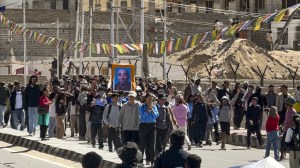Prisoners of the Sun
OF all the allergies one could develop, this has to be the worst. While food reactions may be prevented by limiting exposure to the offendin...

OF all the allergies one could develop, this has to be the worst. While food reactions may be prevented by limiting exposure to the offending substances, and dust allergies avoided by staying away from, well, dust, how on earth does one omit the sun in our tropical country?
What is a sun allergy?
‘‘It’s basically a skin reaction to ultraviolet sun rays (UVR) and visible light,’’ says Dr SC Bharija, senior dermatologist at Sir Ganga Ram Hospital, New Delhi.
‘‘When exposed directly to the sun, allergic skin starts to itch and rashes follow. The reaction then develops into tiny red lesions, blisters or even sunburn.’’
Who is vulnerable?
Some people are photosensitive (sensitive to sunlight) in the same way others react to crustaceans or pollen.
‘‘Patients may not even associate their skin complaint with the light. In fact, it’s not just the bright summer sun that is responsible for the problem, some people also react to the watery winter sun,’’ says Bharija.
So there are no triggers?
Not entirely true. Certain substances exacerbate sun allergies. Here’s the lowdown:
|
SAVE THE SKIN
|
|||||
|
• Confine daytime outings to early mornings or late evenings. And don’t stay out too long. |
|||||
• Photosensitising medications: Diuretics, tetracycline antibiotics and anti-inflammatory agents can lead to unexpected sunburn or a dry or blistering rash.
• Photocontact dermatitis: Contact with various tar products, fragrances and even sunscreens may result in an allergic reaction on sun-exposed skin.
• Phytophoto dermatitis: Blisters and brown streaks may occur from touching certain plants—celery, parsley, carrot, citrus—and following it up with sun exposure. The culprit: Photosensitising psoralen chemicals.
• Cutaneous lupus erythematosus: An autoimmune disease that often affects dark young adult women (as opposed to fair women), it appears as red scaly patches on the cheeks and nose, and occasionally upper back. It leaves white scars.
• Polymorphic light eruption: Again, young adult women are the targets, and the common problem manifests itself in small, irritable pink or red bumps on the arms and possibly chest.
• Solar urticaria: The skin swells within minutes of exposure to UV radiation. The reaction can be very disabling.
How do you know if you’re photosensitive?
Phototests are the best option, says Bharija. ‘‘Photosensitivity induced by contact can be tested with Photopatch tests.’’
And how are such reactions treated?
‘‘Topical ointments and oral drugs are the best bet,’’ says Bharija. ‘‘If further sun exposure is avoided, the rash settles in a few days.’’





- 01
- 02
- 03
- 04
- 05


























